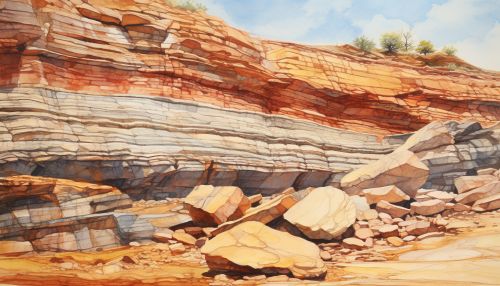Sedimentary rock
Introduction
Sedimentary rock is a type of rock that is formed by the accumulation and subsequent cementation of mineral or organic particles on the Earth's surface, usually in bodies of water. Sedimentary rocks are often deposited in layers, and frequently contain fossils due to the preservation of organisms within the rock material.


Formation
The formation of sedimentary rocks begins with the weathering of pre-existing rocks. The process of weathering involves the breakdown of rocks into smaller particles known as sediments. These sediments are then transported by agents such as water, wind, or ice to a site of deposition. The process of transportation often leads to the sorting of the sediments according to their size, shape, and density.
Once the sediments are deposited, they undergo a process known as lithification. This involves compaction, where the weight of overlying sediments forces the particles closer together, and cementation, where minerals precipitate around the grains and bind them together. The result is the formation of a solid rock.
Classification
Sedimentary rocks are classified into three main groups: clastic, chemical, and organic.
Clastic Sedimentary Rocks
Clastic sedimentary rocks are formed from the accumulation of clastic sediments that are transported and deposited as solid particles. These rocks are further classified based on the size of the sediment particles. Examples include sandstone, formed from sand-sized particles, and shale, formed from clay-sized particles.
Chemical Sedimentary Rocks
Chemical sedimentary rocks are formed from the precipitation of minerals from water. This precipitation can occur either through inorganic processes, such as the evaporation of water, or through organic processes, such as the activity of organisms. Examples of chemical sedimentary rocks include limestone and rock salt.
Organic Sedimentary Rocks
Organic sedimentary rocks are formed from the accumulation of plant and animal debris. This debris is transformed into rock through the process of lithification. Examples of organic sedimentary rocks include coal and oil shale.
Characteristics
Sedimentary rocks exhibit a range of characteristics that are a direct result of the processes that formed them. These characteristics can provide valuable information about the environment in which the rock was formed.
Stratification
One of the most distinctive features of sedimentary rocks is stratification, the layering of rock due to the sequential deposition of sediment. Each layer, or stratum, represents a specific period of deposition, and changes in the nature of the strata can reflect changes in the depositional environment.
Fossils
Sedimentary rocks often contain fossils, the preserved remains or traces of organisms. Fossils are important in the study of sedimentary rocks as they can provide information about the age of the rock and the environment in which it was formed.
Texture
The texture of a sedimentary rock, including the size, shape, and arrangement of the grains, can provide information about the transport and deposition of the sediment.
Importance
Sedimentary rocks have a wide range of uses and are of great economic importance. They are a major source of construction material, and are also used in the production of cement and other industrial materials. In addition, sedimentary rocks such as coal and oil shale are important sources of fossil fuels.
